Sacred Script of Neolithic Europe and Ancient China
Learning from Ancient Chinese Symbols, Sound Frequencies, Ancient Greek and Phoenician Alphabet Art, Symbols and Signs, Spirituality, defaultAncient Chinese Philosophy within Neolithic art symbols and spirituality
by Nataša Pantović
Any discussion of early writing brings up the question of what IS writing? The Western civilizations' researcher will all agree that writing is a way of presenting language using alphabetic, i.e. phonetic symbols. Based on sound, rather that an image, individual letters or syllables represent this sound. The Eastern civilizations' researcher, that had various ways of writing since 5,000 BC would see symbols as writings.
Oracle bone from the reign of King Wu Ding (late Shang dynasty), 5,000 BC
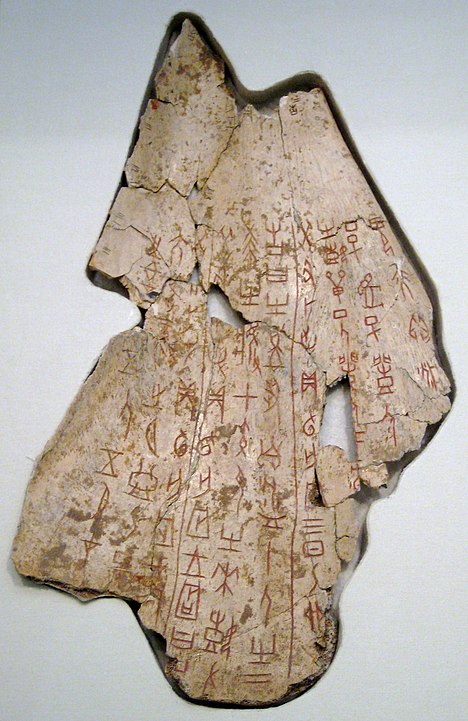
Oracle bone from the reign of King Wu Ding (late Shang dynasty) 5,000 BC
Finding “the language of the gods” based on Root Sounds or Vibrations of the Universe, in a mission of discovering this speach of the Universe, could help a man understand a meaning of a language without ever studying it. Wouldn’t that be just amazing! A man’s mind is both consciously and subconsciously capable of hearing these sounds and matching them with a symbol. For example the Arabic "Ra", connects us with the sound of Sun, as much as “Ma” connects us with the symbol of a Mother.
Also Check The Tao of Logos
Magic of Uniting Visible and Invisible Learning from Amorites 2,000 BC
Ancient Chinese Alphabet Symbols
While exploring the Chinese characters I was mesmerized by the beauty and wisdom hidden within the ancient characters. Now imagine this, to be able to read a child in school needs to learn over 3,000 characters and if ones wishes to study philosophy in Chinese, we step into the world of 35,000 unique characters. What has fascinated me most, is that each drawn character builds a unique story, beauty will speak of a beauty of a flower, or an artwork or youth. What most of us do not know is that apart from the amazing world of pictures that is equally readable to a Chinese or a Japanese or a Korean scholar, we also get a sort of phonetic compounds. Examples are 河he "river", 湖hu "lake", 滑hua "slippery". All these characters have on the left a radical of three short strokes (氵), which is a reduced form of shuei that is water. So, if we travel back to the ancient alphabet, the one that was used to write prayers, ritual, or messages to after-world Gods, we come to some inspiring findings.
Cangjie 2,500 BC Chinese characters Official Inventor
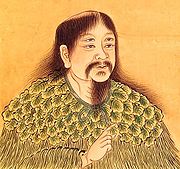
Cangjie 2,500 BC Chinese characters Science Recognized Official Inventor
Cangjie (2650 BC) lived in ancient China at the time of the Yellow Emperor and was his official historian. Such an advanced civilization, to have an Official Historian!
Neolithic Chinese Symbols, Characters and Sounds
The Mystery of Babylon Tower and the confusion of tongues (confusio linguarum)....
Ancient Chinese character for B Beo White Bianco Bright Abjad
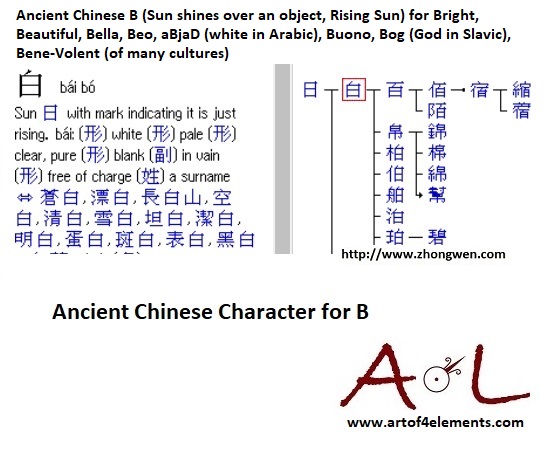
Symbol B Ancient Chinese character for B Beo White Bianco Bright Abjad Sacred Script of Neolithic Europe and China
Ancient Chinese character for F as Father
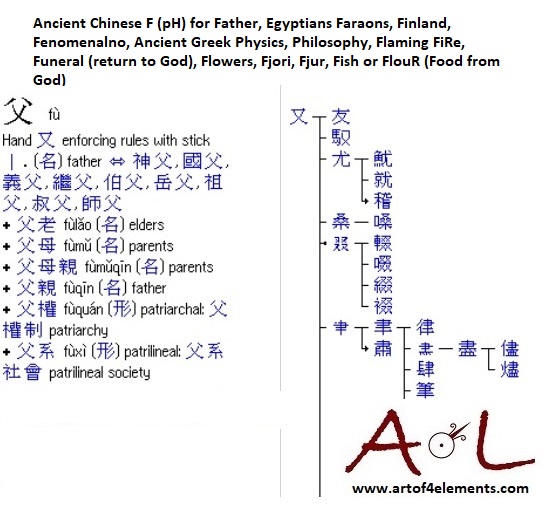
Letter F Ancient Chinese character for F as Father Phenicians Faraons Philosophy Sacred Script of Neolithic Europe and China
One of the earliest ancestors, from this Western side of the planet of our powerful sound F that consists of P+H were Phoenicians and Ancient Greeks some 2,500 BC. As a sacred syllabus it carried the names of Pharaohs, the force of Arabic Phoenicians, the unity of the Family, the dreams of Ferries, Flames of Fire and Flamingos Flight.
Ancient Chinese character for SCH European SH or Shui as God or divine in human, Supreme
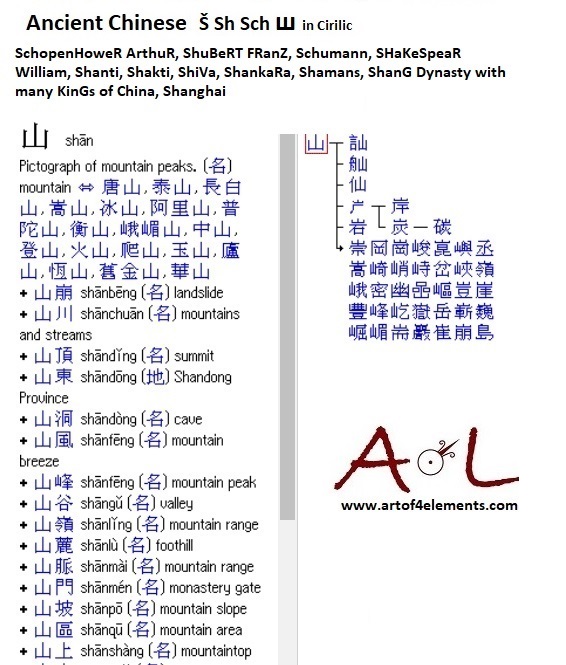
Ancient Chinese character for Š European SH or shui as God divine in human supreme Sacred Script of Neolithic Europe and China
Shen (神) is the Chinese word for god, deity, spirit or theos. A starting point for an understanding of shen is that according to the ancient Chinese, Human is the meeting place of Heaven and Earth. Their number 10 is symbolically depicted as +In Chinese ancient philosophy yin and yang is a concept of dualism, and we find it mapped within the mystical Jewish Kabbalah and within Hindus sacred texts exploring mantras and meditations. The Ancient Chinese wise or educated men spent lifetimes researching how these seemingly opposite or contrary forces may actually be complementary, and interconnected. Various cultures have translated this wisdom working with the music, symbolism, sounds. While reading any mystical or magical texts, try to go back to the originals, for many a wisdom has been lost in translations and most colourful human intentions.
Ancient Chinese character for X European H or xin meaning mind mental state Heart
Ancient Chinese character for N for Nirvana, Night, YiN
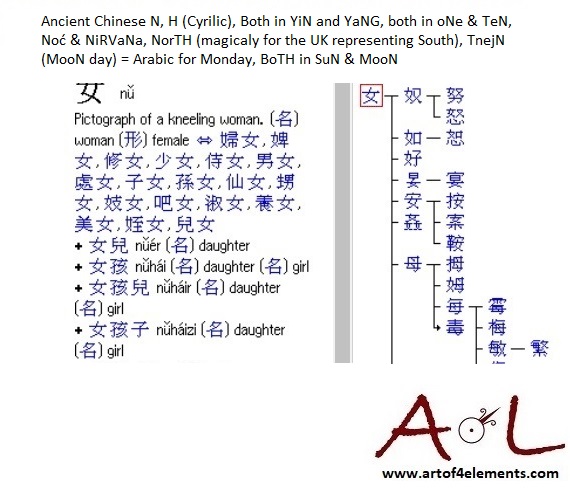
Alphabet Symbol N in Ancient Chinese character for N Sacred Script of Neolithic Europe and Ancient China
Ancient Chinese character for Z as Zen, Zrak, Zdravlje, Zaratusta
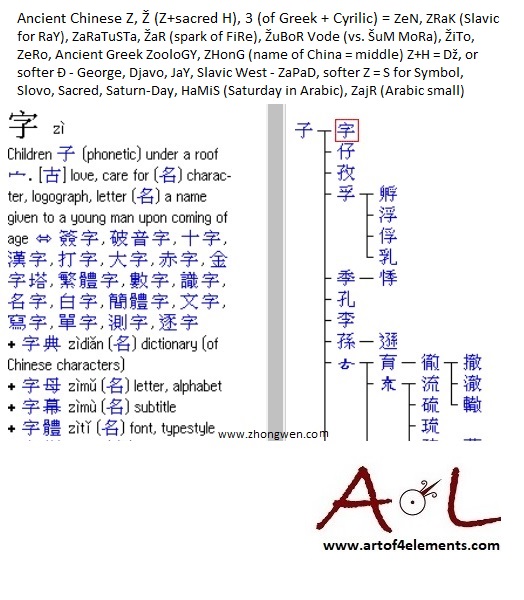
Symbol Z in Ancient Chinese character for Z Sacred Script of Neolithic Europe influence of China Zen Zar Zlato
Yi Chinese character representing One
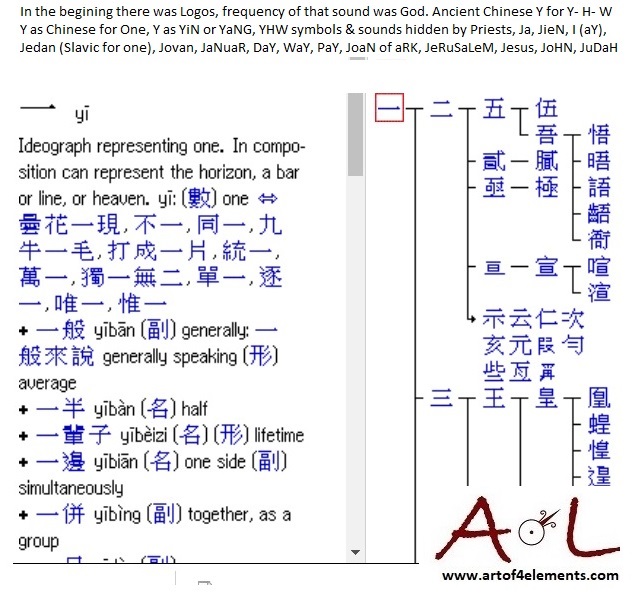
Yi Chinese character representing One I Io Jahowa Jedan Sacred Script of Neolithic Europe and Influece of China
Ancient Worlds and Sound M
What about M. Within the Eastern philosophical thought M was reserved for Mantra: A word that is sang for God; a vibrational sound found in many forms used to change states of consciousness. It is found in the word of Meditation: meaning a spiritual practice of usually silent prayers known as contemplation, and achieved after concentration. In the late nineteenth century, Theosophists explain "meditation" as a tool used by various spiritual practices drawn from Hinduism, Buddhism, and other Eastern religions. It is found in the word Metaphysics: (Greek meta = beyond and physics = nature). It is found in the word Mind referring to imagination and memory, or within China referring to both thoughts and feelings. We find it in the word Miracle, or Moksha: (Sanskrit मोक्ष Mukti. It also hides Muraqaba: the Sufi word for meditation. Literally meaning "to watch over" and Mysticism: From the Greek mueo "to conceal", a conscious awareness of the divine usually through art and music. In the Hellenistic world, "mystical" referred to secret religious rituals.For R please Check https://www.artof4elements.com/entry/244/el-ra-ma
For H do Check https://www.artof4elements.com/entry/246/the-god-vibration
Neolithic China
Dadiwan, Damaidi from the 5,000 BC
Travelling back in time, even further back, just during the last few decades, our knowledgeable archaeologists, have found a series of inscribed graphs and pictures at Neolitic sites in China, Dadiwan, Damaidi, Banpo(5,000 BC).
Just a word of caution, we at this point have to remind ourselves that we had no writing nor reading whatsoever distributed amongst scholars, unless done by Kings, during the last 2,000 years of our most recent history. The scripts were considered sacred and were hidden within the monastery walls or Palaces, belonging to the rich. They were FEW! Before the Age of Enlightenment, in Europe, no books other than Bible could be found in the cities. Pre-electricity, that is just a 100 years ago, 99 % of the people all around our little planet could not read nor write. Holding a 16 century Plato’s book in my hands, I could witness how fragile and small books at the time were. So now, when a scientist tells me: 5,000 years BC, I have a deep respect for the archeological findings that is this old. I will not expect an ancient paper copy of the Sunday Times, the finding will be the scripts, symbols carved on the Oracle bones (the shell that is durable for 1,000s of years) or if we are truly lucky, we might hope to find a pottery artefact
Ancient China Dawenkou
An inscription bearing artifacts from the Dawenkou culture, Shandog, are dating to 2800 BC, are from the Longshan culture, descendants of which are the Shang, where the first undisputed Chinese writing appears. At a Dawenkou 陵陽河 大朱村, eighteen isolated pictorial symbols of eight types carved or painted with cinnabar on sixteen pottery jars have been found, excavated from wealthier tombs.
A Chinese Archaeologist, Yu Xingwu hasidentified the circle-and-cloud graph as the Chinese character for "dawn", 旦
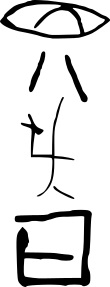
Jiahu writing 6,000 BC Ancient China
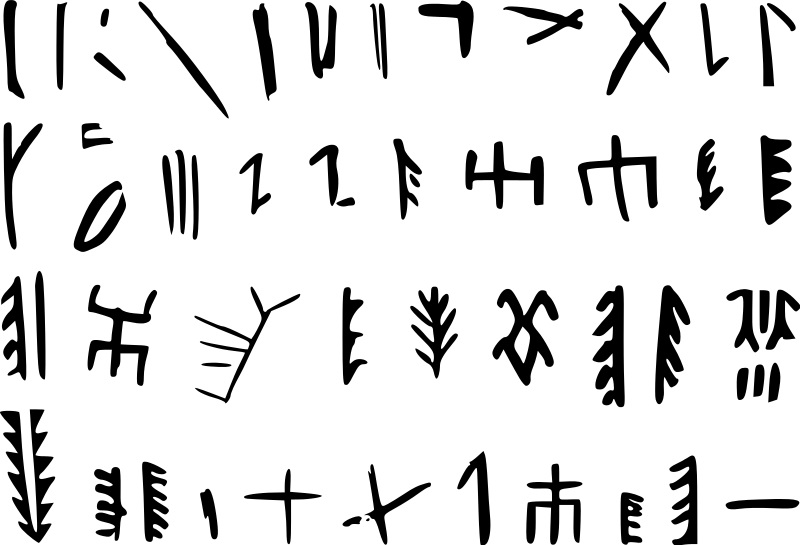
Banpo pottery symbols Ancient China 5,000 BC
The symbols found resemble the ancient pictographic script discovered in the Neolithic China so there is no doubt that they can be viewed as the pioneers of primitive writing.
Longshan culture
Eleven characters found on a pottery shard, Longshan culture

Banpo signs symbols Ancient China 5000 BC
Comparing various Languages in Neolithic Europe to Understand the development of Sound
My dear consciousness researchers, the sound resonance on our little planet is supreme. During the Valletta Film Festival, I have a pleasure to see The Hypnotist, a documentary film from Finland, with a story about Master hypnotist Olliver Hawk (1930–1988), who having started his career in Australia, became famous in Finland in the 1960s when hundreds of thousands of people saw Hawk’s hypnosis show. His mission in life was within the use of the sacred sounds within his hypnosis work, and he believed that hypnosis was used by the Finish dictator to stay in power and break the democracy, by the army leaders, by the state officials, and that he with his knowledge of the sound frequencies had a profound influence on the political life in Finland.
Neolithic Europe and Ancient Chinese Alphabet
|
Chinese |
English |
|
Latin |
Ancient Greek |
Sanskrit |
Arabic |
Slavic |
|
2,500 BC |
|
|
c. 100 BC |
2,500 BC |
|
Pure Arabic spoken in Malta |
Slavic (Serbian, Bulgarian, Macedonian)
|
|
Mu |
mother |
|
māter |
mḗtēr |
mā́tṛ |
Ma |
mati |
|
Fu |
father |
|
pater |
patḗr |
pitṛ́ |
MissiR |
otac |
|
|
son |
|
|
huiós |
sūnú |
|
sin |
|
|
|
|
|
|
|
|
|
|
Zi "Self" |
H-uman |
|
homō |
anḗr |
jana person |
Raggel |
Čovek |
|
|
|
|
|
|
|
|
|
|
|
Woman, wife |
|
|
gunḗ |
gnā, jániḥ, jánī |
MaRa |
Žena |
|
|
I |
|
egō |
egṓ, egṓn |
ahám |
Yina |
Ya |
|
Yi |
one |
|
ūnus |
oĩnos or oĩ(w)os "alone" |
ēka |
|
jedan - yedan |
|
Ar |
two |
|
duo |
dúō "two" |
dvā́(u) |
|
dva |
|
|
hundred |
|
centum |
he-katón "hundred" |
śatám"hundred" |
|
sto |
| Old Greek | Root form | Meaning | Deriving from | Slavic |
| ἄβυσσος | ábussos | abyss | a (negation) + Bu (light in Chinese) | Bu-dan = Awake |
| ἅγιος | ἁγιο- | holy | A-Yi (from Ya-Ho-Wa) | Sveti |
| θ used to represent Theos | ||||
| ἀθλητής | athlētḗs | athlete | Ἀ θ λητ- | Atleta |
| αἰσθητικός | aisthētikós | αἰσθη- | S + θ + Ko | Astetika |
| ἀμφιθέατρον | amphithéatron | theatre | God's Hall | Amfitiatar |
| ἄνθος | ánthos | Flower | Towards θ | CveT |
| ἀντιτίθημι | antitíthēmi | ἀντιθ- | Anti Theo | bez božno |
| ἀριθμός | arithmós | A-R-θ-M = θ between Ra and Ma = numbers | BroJevi | |
| αὐθεντικός | αὐθεντικ- | Au + Theos + T + K (ka, booK, kodba) | Original (R + G + L) | |
| H = Sound of God, hidden from sacred scripts by Priests as the Name of God not to be altered in vein. Becoming ScH, SH, CH, PH | ||||
| hem- | blood | |||
| ἁπλόος | haplóos | ἁπλο- | single | Jedini (Ye-Dini) |
| ἁρμονία | harmonía | Ha+Ra+Ma+Ya (Supreme God + trinity) | harmonija | |
| ἀρχαῖος | arkhaîos | ARK + Ha | ancient | arheolog |
| ἀρχή | arkhḗ | ARK + He | chief, authority, archbishop | |
| ἀρχιτέκτων | arkhitéktōn | ARK + Hi + TKT | chief builder | architect |
| ἁψίς | hapsís | arch | STUB | |
| ἕλιξ | hélix | ἑλικ- | spiral | |
| ἑπτά | heptá | ἑπτα- | seven | Se-DaM |
| Θ | ||||
| th | ||||
| ἥλιος | hḗlios | helium, heliotropic, heliocentric | sun / sun-god | |
| θεός | theós | θεο- | ||
| god | words with theo- | |||
| -thermy, -thermia | hot | words with thermo- | ||
| θησαυρός | thēsaurós | θησ- | treasure | |
| ἴδιος | ídios | ἰδι- | one’s own, private | |
| ἱερός | hierós | ἱερο- | sacred | |
| ἵππος | híppos | ἱππο- | horse | |
| ἰχθύς | ikhthús | ἰχθυ- | fish | |
| K | Akadēmía | the school where Plato taught | Ka – knowledge De – Dio | |
| Ἀκαδημία | acoustic- | Ἀ + κο (knowledge) σ (sound) τικ | acoustics | |
| ἀκούω | ||||
| K + R | ákron | acrobat | edge, at the top | |
| ἄκρον | ||||
| álpha | alpha- | alpha | alphabet | |
| ἄλφα | ánarkhos | ἀναρχ- | without R + CH | |
| ἄναρχος | ||||
| anḗr | towards R God | man (male human) | ČoVeK | |
| ἀνήρ | áneimi | towards M Goddess | to go up | uZDiGni |
| ἄνειμι | ||||
| ántron | Terra Re Nirvana | cave | Pećina | |
| ἄντρον | ||||
| áxios | a+xi (treasure) | worthy | ||
| ἄξιος | Aó-ristos | similar to Hristos | indefinite | aoristic, aorist |
| ἀόριστος | ||||
| Árēs | Ra | Mars | ||
| Ἄρης | ||||
| áristos | similar to Hristos | aristocracy | ||
| ἄριστος | ||||
| Átlas | ἀτλα- | name of a Titan | Atlantic | |
| Ἄτλας | átomos | ἀτομ- | un + cut | atom |
| ἄτομος | ||||
| autárkeia | autarky | self-sufficiency | ||
| αὐτάρκεια | auxánō | αὐξ- | to increase | |
| αὐξάνω | autós | αὐ+Tο | self | autonomija |
| αὐτός | ||||
| Β | bárbaros | The one who worships B (Bog-a) | stranger, non-Greek | Stranac |
| βάρβαρος | bíos | βιο- | life | ŽivoT |
| βίος | ||||
| Γ | gaîa | Ga + Ya sound frequency of Gods | earth | ZemLja |
| γαῖα | gámos | Ga + Ma (Male + Female) | marriage | VenČaNje |
| γάμος | gunḗ | woman | ŽeNa | |
| γυνή | ||||
| Δ | dêmos | district, its inhabitants, commoners | democracy, demographic | |
| δῆμος | dóxa | glory, opinion | Pravoslavno | |
| δόξα | drâsis | action | drama, G-lu-Ma | |





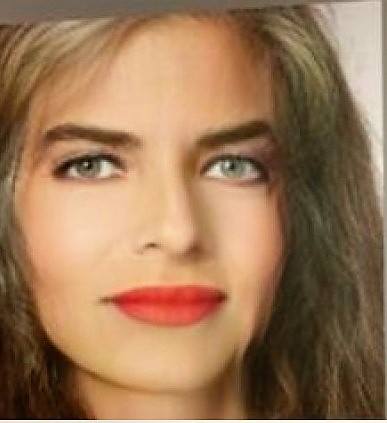
Sacred Script of Neolithic Europe and Ancient China No comments on Sacred Script of Neolithic Europe and Ancient China: